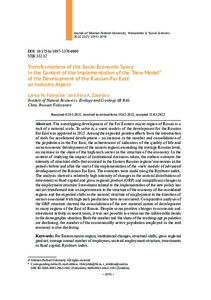Transformations of the Socio-Economic Space in the Context of the Implementation of the “New Model” of the Development of the Russian Far East: an Industry Aspect
Скачать файл:
URI (для ссылок/цитирований):
https://elib.sfu-kras.ru/handle/2311/145601Автор:
Faleychik, Larisa M.
Zabelina, Irina A.
Фалейчик, Л. М.
Забелина, И. А.
Дата:
2022-07Журнал:
Журнал Сибирского федерального университета. Гуманитарные науки. Journal of Siberian Federal University. Humanities & Social Sciences; 2022 15 (7)Аннотация:
The outstripping development of the Far Eastern macro-region of Russia is a task of a national scale. To solve it, a «new model» of the development for the Russian Far East was approved in 2013. Among the expected positive effects from the introduction of tools for accelerated development – an increase in the number and consolidation of the population in the Far East, the achievement of indicators of the quality of life and socio-economic development of the eastern regions exceeding the average Russian level, an increase in the share of the high-tech sector in the structure of the economy. In the context of studying the impact of institutional decisions taken, the authors estimate the intensity of structural shifts that occurred in the Eastern Russian regions’ economies in the periods before and after the start of the implementation of the «new model» of advanced development of the Russian Far East. The estimates were made using the Ryabtsev index. The analysis showed a relatively high intensity of changes in the sectoral distributions of investment in fixed capital and gross regional product (GRP) and insignificant changes in the employment structure. Investment related to the implementation of the new policy has not yet transformed into an improvement in the structure of the economy of the considered regions and the expected shifts in the sectoral structure of employment in the direction of sectors associated with high-tech production have not occurred. Comparative analysis of the GRP structure showed the consolidation of the raw material nature of development in many regions of the East of Russia. Despite some positive changes in economic and investment activity in recent years, it was not possible to overcome the unfavorable trends in the demographic situation. Both the number and the share of the working-age population are declining; the number of the economically active population employed in the real economy is also declining В настоящее время опережающее развитие Дальнего Востока РФ
рассматривается как задача общенационального масштаба. На ее решение
направлена принятая в 2013 г. «новая модель» развития Дальнего Востока РФ.
В числе ожидаемых положительных эффектов от введения инструментов ускоренного
развития – увеличение численности и закрепление населения на Дальнем Востоке,
достижение показателей качества жизни и социально-экономического
развития
восточных регионов, превышающих среднероссийский уровень, увеличение доли
высокотехнологичного сектора в структуре экономики. В контексте исследования
влияния предпринятых институциональных решений оценивается интенсивность
отраслевых структурных сдвигов, произошедших в экономиках восточных субъектов
РФ в периоды до и после начала реализации «новой модели» опережающего развития
Дальнего Востока РФ. Оценки выполнены с использованием индекса Рябцева.
Анализ показал относительно высокую интенсивность изменений в отраслевых
распределениях инвестиций и валового регионального продукта и незначительные
изменения в структуре занятости. Инвестирование, связанное с реализацией новой
политики, пока не привело к улучшению структуры экономики рассмотренных
регионов, не произошло ожидаемых сдвигов в отраслевой структуре занятости
в сторону отраслей, связанных с высокотехнологичным производством. Сравнительный
анализ структуры ВРП показал, что во многих регионах Востока России отмечается
закрепление сырьевого характера развития. Несмотря на отдельные позитивные
изменения в экономической и инвестиционной деятельности за последние годы,
неблагоприятные тренды демографической ситуации преодолеть не удалось.
Сокращается как численность, так и доля трудоспособного населения; снижается
и численность экономически активного населения, занятого в реальной экономике

